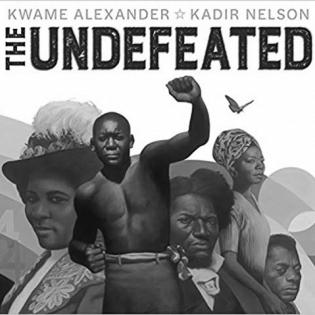The Undefeated Literature Guide
Kwame Alexander’s award winning book “The Undefeated” is a poem to celebrate the creativity, perseverance, grit and impact of Black Americans on the history of the United States of America. It is both a call to action and a reminder to all that we must never give up.
Literature guide by Maureen Klein
Before Reading
Ask: What does it mean to be undefeated? How would you describe that word? Note that in this case, it doesn't mean the same as "always a winner."
Show: Show the full book cover, both front and back. Invite the listeners to share what they notice. Prompt them to look beyond the people.
Connect: The Undefeated is a picture book that is based on Kwame Alexander’s poem. As you listen to the poem, pay close attention to the illustrations in the book. The poem and pictures combine to honor and celebrate historical figures and events in Black History. Some events and people may be familiar to you and others may not.
During Reading
Show: Show the page with the words “And the ones who didn’t.”
Ask: What do you notice about this page? (Note - there are no illustrations and the word didn’t is in a larger font) Why might the page be blank? Why might the word didn’t be larger than the other words?
Connect: The author and illustrator have emphasized certain words and their connection to specific people and events in black history. Continue to notice the connection between the words and the illustrations. Writers and illustrators use different techniques to call attention to words and meanings. What do you do when you want to call attention to something in your writing or speaking?
After Reading
Ask: The theme of The Undefeated is perseverance. How did the author describe the people who were undefeated? How might you describe them? If needed, re-read a page of the book and highlight the word that completes the sentence, “This is for the …”
Show: Show the last page which ends with “This is for us.”
Connect: What’s different about the illustrations on this page? If needed, prompt students to describe the people on the page (they are children). Why might the author have ended his book this way? What is he trying to tell us?
Activities
- Listen to the NPR interview with illustrator Kadir Nelson. Discuss what stood out in the interview. How did the interview enhance your understanding of the book? Be sure to show the specific illustrations that are discussed in the interview.
- Watch this video of Kwame Alexander reciting his poem. Individually or as a group, compare and contrast the differences between the book and the video.
- As an extension, use the names and information mentioned in the back of the book The Undefeated as the focus of a mini-biography project. Investigate the historical people in the book and create a poster of an individual historical figure. This activity can be done on paper or electronically. See the handouts below, which include links to copy from Google Docs.
Note for Educators: To foster empathy and build a more socially just society, we must intentionally embed culturally and racially diverse instruction throughout the disciplines throughout the year. We can use literature and share the stories of diverse people, like in this book, to repair the wounds from years of silence and highlight the valuable contributions and experiences of diverse people.
Additional Resources
- “Hidden Figures” by Margot Lee Shetterly
- “28 Days: Moments in Black History that Changed the World” by Charles R. Smith
- “Let the Children March” by Monica Clark-Robinson
